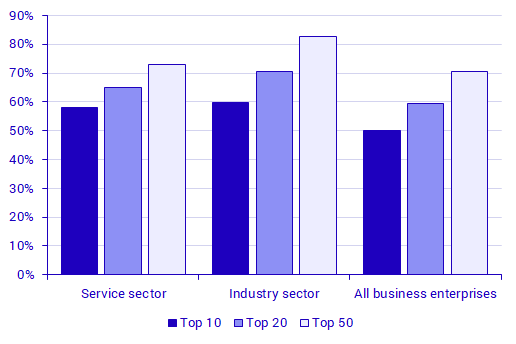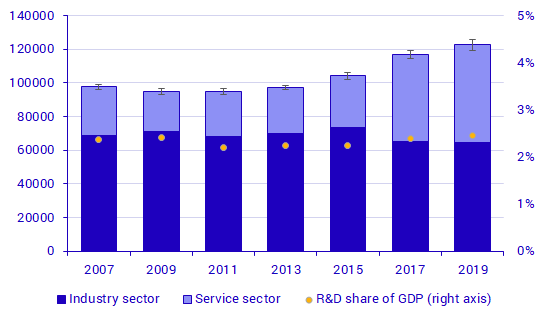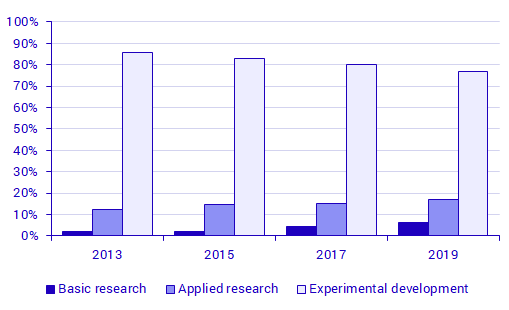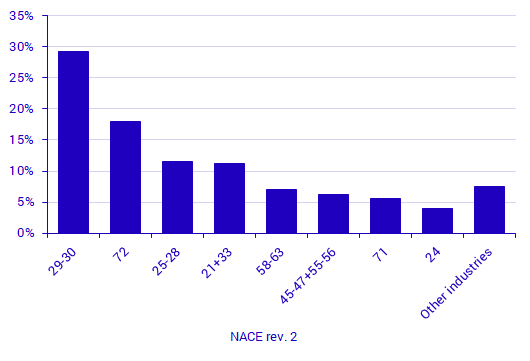Research and Development in the business sector 2019
Ten companies accounted for half of business enterprise R&D in 2019
Statistical news from Statistics Sweden 2020-10-15 9.30
A handful of large enterprises perform the majority of R&D in Sweden’s business sector. At the same time, total R&D expenditure continues to increase.
Approximately 3 063 business enterprises performed R&D in Sweden in 2019, of which 1 865 were in the service sector and 1 198 were in the industry sector. Ten of these enterprises accounted for 50 percent, while fifty enterprises accounted for 71 percent, of total R&D expenditure. The R&D concentration is somewhat larger in the industry sector, in which the fifty largest R&D performers accounted for 83 percent of total expenditure. The corresponding percentage in the service sector was 73 percent.

R&D expenditure continues to increase
Business enterprise intramural R&D amounted to SEK 122.7 (± 3.2) billion in 2019. This means that the expenditure is estimated to have increased by SEK 6.1 billion in fixed prices between 2017 and 2019. Expenditure in service companies increased by SEK 6.5 billion, while industry companies noted a statistically insignificant decrease of SEK 0.4 billion between the same years. This implies that the trend of increasing total R&D expenditure that started in 2013 is persisting. R&D expenditure as a share of GDP was estimated at 2.44 percent, which is the largest share since the start of the time series in 2007. At the same time, this share has been relatively stable throughout the time period, in which the lowest share was 2.20 percent, in 2011. The number of R&D full-time equivalents in 2019 was estimated at 64 641, while the corresponding figure in 2017 was 63 729. This increase is not statistically significant.

Experimental development is the most common type of R&D
Since 2013, business enterprises have classified their R&D expenditure in the categories basic research, applied research, and experimental development. Simply put, the categories are based on the scope of potential application of the results of R&D projects, in which basic research has the broadest potential, and experimental development has the most specific expected application. In 2019, experimental development accounted for 77 percent, the largest share of business R&D. The second largest type, at 17 percent, was applied research. Basic research accounted for 6 percent, the smallest share of total R&D. However, since 2013 the estimated research shares have increased somewhat in every survey year.

Most research is done in the industry for transport equipment
Basic research is uncommon in the business enterprise sector, and is more generally associated with the higher education sector. This is in part explained by the fact that there are often no foreseeable commercial applications of basic research in the short term. Applied research, which often consists of exploring promising results from basic research, is more common in the business enterprise sector. The largest share of research, 29 percent out of SEK 28.2 (± 1.0) billion, was performed in the industry for transport equipment (NACE 29-30). This was followed by institutes for scientific research and development (NACE 72), at 18 percent. The aggregate industry for fabricated metal products, except machinery and equipment, industry for computer, electronic and optical products, industry for electrical equipment, and the industry for machinery and equipment n.e.c. (NACE 25-28) accounted for 11 percent. The industry for basic pharmaceutical products and pharmaceutical preparations and repair shops and installation companies for machinery and equipment (NACE 21 + 33) together also accounted for 11 percent. Wholesale and retail trade, and accommodation and food service activities (NACE 45-47 and 55-56) accounted for 6 percent. Architects’ offices, technical consultancy companies, companies for technical testing and analysis (NACE 71) accounted for 6 percent. The industry for basic metals (NACE 24) accounted for 4 percent, and other remaining industries together accounted for 7 percent of business enterprise expenditure on intramural research.

Definitions and explanations
All R&D statistics are based on the concepts and definitions in the OECD Frascati manual 2015.
Presentation by industry
The somewhat unusual combination of industries (NACE 21 + 33) in this presentation is used to ensure the protection of individual company data.
Further information
For further information, or if you have questions on the results, please contact us.
Publication
In this year’s survey, questions were added concerning artificial intelligence, in view of a government task to Statistics Sweden from the Ministry of Infrastructure, Ref. no I2019/01964/D. These statistics will be included in a separate report to be published on 25 November 2020 on the product web page on research and development in Sweden, at scb.se/UF0301.
Statistical Database
More information is available in the Statistical Database
Feel free to use the facts from this statistical news but remember to state Source: Statistics Sweden.
